

Unkover your competitors’ Marketing Secrets
Say goodbye to wasting hours on competitor analysis by equipping your team with an AI-driven, always-on competitive intelligence platform.


Say goodbye to wasting hours on competitor analysis by equipping your team with an AI-driven, always-on competitive intelligence platform.

Stay Ahead with AI-DRIVEN Competitive Intelligence
Unkover is your AI-driven Competitive Intelligence team delivering critical updates about your competitors the moment they happen:
Track your competitors website changes
Why spend all day stalking the competition when you don’t have to?
With Unkover, you’ll know instantly when your competitors tweak their messaging or shake up their pricing. No more endless scrolling through their sites or second-guessing your strategies.
Let us do the heavy lifting for you, ensuring you’re always in the loop by notifying you the moment a critical change happens on your competitor’s pages.
Sit back, relax, and keep winning—Unkover makes sure you’re not just in the game, you’re always a step ahead.


Read your competitors emails
Companies love updating their customers and prospects about relevant news, product updates, and special offers.
That juicy info from your competitors? It’s yours too. Unkover will automatically capture all their emails and bring them right to your doorstep—accessible to your entire team, anytime.
[COMING SOON: Our fine-tuned AI will sift through these emails, extract key information and send them over to the best team within your org. Less noise, more signal!]
We hear you! Unkover’s goal is not to flood you with tons of data points that no one in your team will ever read. We gather competitive intelligence from thousands of data sources and use AI to highlight actionable information to the right team in your company.
Say goodbye to noise. We’re 100% signal.
ROADMAP
We’re excited to get Unkover in your hands as soon as possible and keep building the best competitive intelligence tool with your precious feedback. The roadmap for the next few months is already exciting, so take a look!
While we build and deliver, here’s our promise to you: as an early tester and customer, you’ll lock in an exclusive bargain price we’ll never offer again in the future.

Spy on your competitors’ full marketing strategy: social, ads, content marketing, email flows, and more.

Track competitive Win/Loss analysis and build battle cards. Get alerted at every pricing change.

Get immediate alerts when competitors announce new features or major releases. Identify strengths and weaknesses from online reviews.

Get the competitive intelligence you need where you need it: Slack, eMail, MS Teams, Salesforce, Hubspot, Pipedrive and more.
slack integration
Unkover’s Slack integration lets you keep your whole team up to speed with your competitors’ updates.

Join now to lock in an exclusive 50% lifetime discount
For startups and small teams, it’s the essential toolkit you need to keep an eye on a select few competitors.

Up to 5 competitors

50 pages monitored

10 email workflows

3-day data refresh
$39
/per month
$ 79
50% discount
Billed annually
For growing businesses, it allows you to monitor more competitors, pages, and email workflows.

Up to 10 competitors

100 pages monitored

20 email workflows

1-day data refresh
$79
/per month
$ 159
50% discount
Billed annually
For large companies, it is tailored to meet the needs of multiple teams needing granular insights.

Custom number of competitors

Custom number of pages monitored

Custom number of email workflows

Hourly data refresh
Custom price
Billed annually

Over the past decade, we’re sure that you’ve noticed that your marketing tech stack options have become much more advanced than ever before.
Social media management software doesn’t just let you publish content around the clock; it actually recommends hashtags to add or when to publish.
And website analytics platforms don’t just show you a flat number of site visitors; they show you paths taken through a site, what CTA buttons users have hovered over, and which pages they’ve interacted with for the longest.
We’ve gone beyond basic data analytics, and now different types of marketing and sales technology are using advanced machine learning and high-quality data to deliver better and more actionable insights than ever before.
Lead scoring is another great example. Manually scoring leads is practically migraine-inducing, and traditional lead scoring left much to be desired. Technology today, however, has paved the way for predictive lead-scoring tools, and that’s what we’ll be talking about today.
In this article, we’ll cover what predictive lead scoring is, the difference between manual and predictive lead scoring, and considerations to make before you dive in.
Let’s get started!
Traditional lead scoring—which is also sometimes called “manual lead scoring”—is the process of ranking your leads based on several different factors to determine how likely they are to take a certain action.
In many cases, traditional lead scoring focused almost exclusively on acquiring new customers by converting them from leads that were in the brand’s sales funnel.
Typically, traditional lead scoring relied on giving different demographic attributions and potentially different actions customers could take and giving each one a metric score. You’d add up all of an individual lead’s different attributes for a numeric score ranging from 1-100, and the higher the score was, the more likely the lead was to convert.
Even once lead scoring became more digital and didn’t require someone wracking up the counts themselves, it still relied entirely on team members to determine which qualities or actions deserved what scores. This was a manual, tedious, and prone-to-error process.
This usually involves scouring your database of thousands of contacts for the right combination of attributes that equal the perfect lead–which is by no means an easy feat, and it means that the data wasn’t always particularly accurate.
If you want to try it out, we’ve developed a lead scoring template that allows you to dip your toe into the world of manual lead scoring.
Predictive lead scoring uses a combination of high-quality and up-to-date data and machine-learning capabilities.
This type of lead scoring will pull in data from multiple sources and then utilize machine-learning algorithms to assess which behaviors and attributions of existing prospects and customers could signal high intent. The systems then create models based on those behaviors and traits so that you can assess new leads against them.
Some tools go beyond initial lead scoring and open the door to what we’ll call “contact scoring.” You are looking for multiple methods of revenue-boosting potential, like upselling or re-engagement.
The biggest difference is easy to see: Traditional lead scoring is heavily manual, and it relies on in-depth manual analysis, a lot of strategic thinking, and a bit of luck to really get your lead scoring models right.
Predictive lead scoring will pull data from a single or multiple sources and then do some of the heavy lifting for you. It will determine what your ICP looks like and what traits and actions indicate your best chance of success.
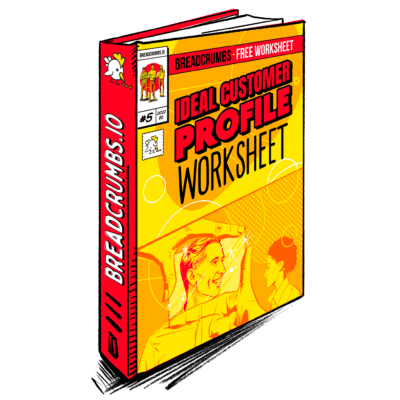
Ebook
Ideal Customer Profile (ICP) Worksheet
Learn how to create an Ideal Customer Profile and build a successful sales strategy with this Ideal Customer Profile (ICP) Worksheet.
So predictive lead scoring has some strong advantages, but conventionally, it’s also had some serious drawbacks.
Frequently, predictive lead scoring systems have a “one size fits all” solution and models that don’t consider the temporal scoring changes (i.e., changes in business priorities/directions).
Suppose your system has a set model of what it interprets as your ideal customer, and your business changes niches or verticals. In that case, this can misalign your entire scoring system and cause chaos in the sales and marketing department.
In addition, pushing data into a system and hoping for the perfect outcome is fraught with potential issues. Ideally, you should want to prepare your data, the time frame of the data you are using, and ensure it is aligned with your objectives (i.e., more enterprise leads and purchases.)
You don’t want to be drowning in the time-suck that is traditional lead scoring, especially considering it’s not always incredibly accurate.
And you also don’t want to be stuck with an inflexible predictive lead scoring tool that locks you into models that aren’t adaptable for an always-changing business and market.
The solution is to find an advanced predictive lead-scoring tool that utilizes machine learning to identify high-value traits and actions to help suggest models while allowing you to test and customize those models on an ongoing basis.
That’s where Breadcrumbs comes in, giving you the best of both worlds—the automation and insights of machine learning with the adaptability and control of human oversight.
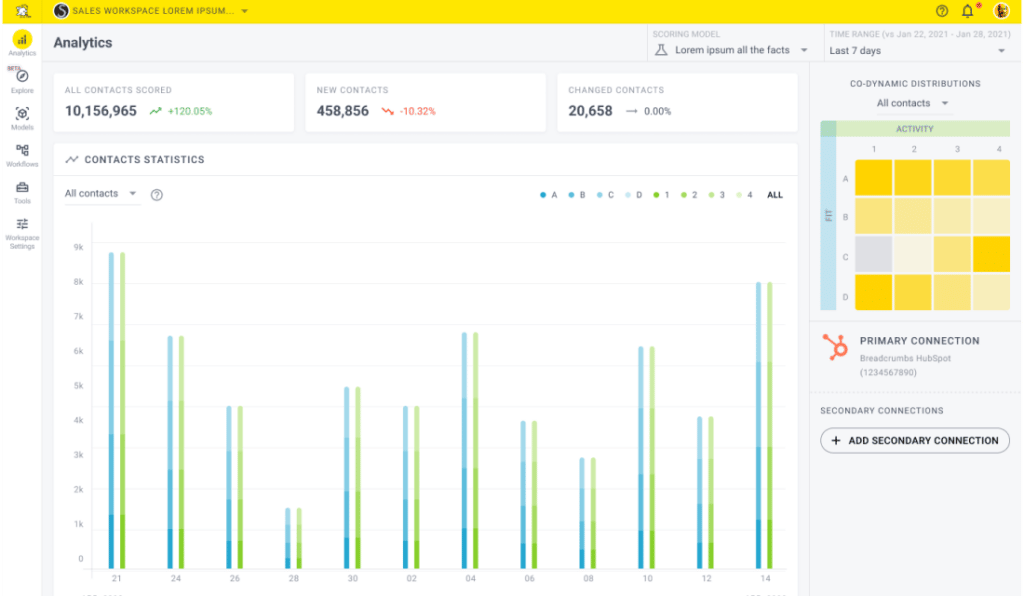
At Breadcrumbs, we recommend (and offer) a machine learning-assisted system–a blend of the two approaches.
The synchronicity created by your sales and marketing team aligned on your ideal customer attributes, as well as the efficiency of added machine learning behavioral predictions, is one of the tenants of our Revenue Acceleration Manifesto.
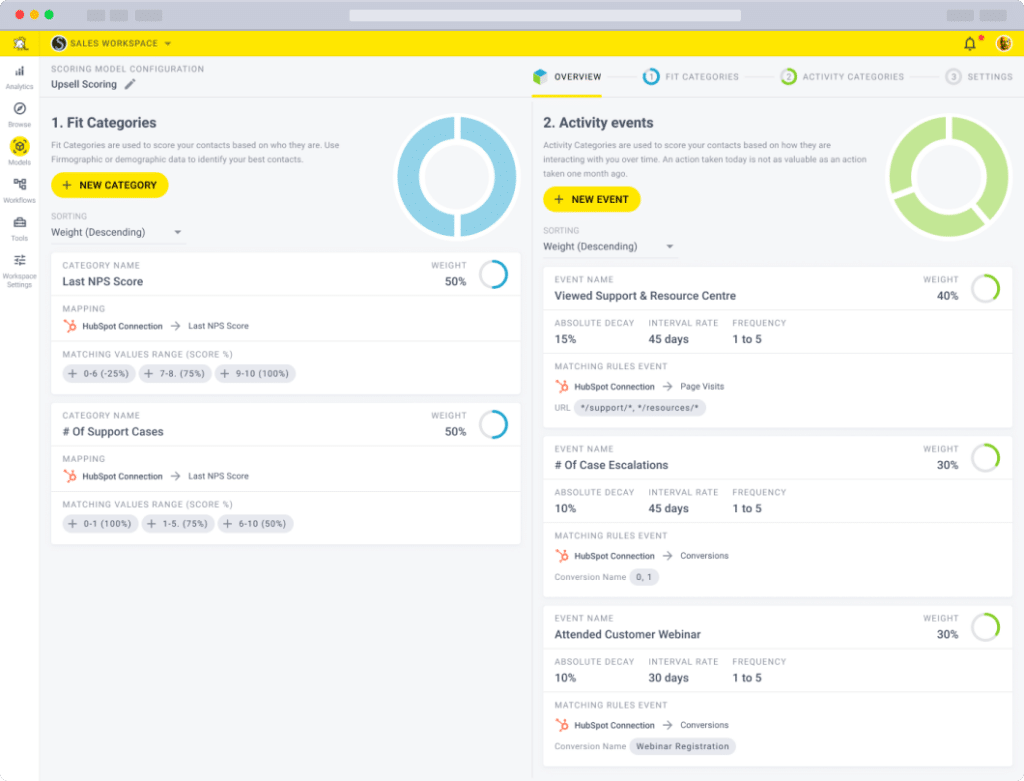
This is why we put together 3 key ingredients and mixed them up with a robust algorithm to cook up the perfect recipe for a perfect lead-scoring model for you and your business.
Recency is one of the first factors we look at with our lead scoring process. This is because it is crucial to know how recently your lead has taken action with your company assets. In this sense, recency allows you to evaluate and prioritize activities that are currently happening instead of wasting time chasing up leads that are 2+ years old.
Because of this, decay is factored into all of our models. Our machine-learning tech will make recommendations on a basic decay formula, but you can customize the decay’s impact on scores based on your customer journey.
Those with a longer sales cycle will typically want to stretch out their times whereas a B2C company selling tech products would work within shorter timeframes.
This will help your sales team accurately assess leads based on the timing of the actions they’ve taken so they can strike while the iron is hot.
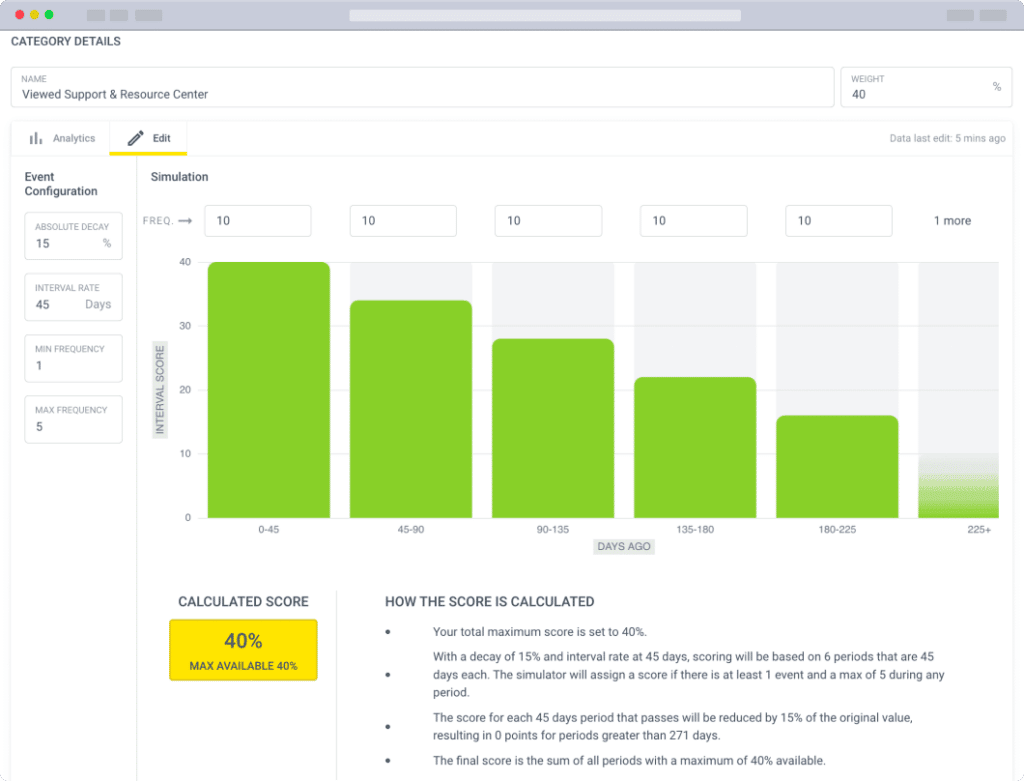
Another important indicator that helps prioritize your leads is frequency. It means you can count how often they raise their hand at what you propose to them. Those who have recent activity with your organization and frequently interact with your company should be the top leads your goes for.
It’s crucial to choose a lead scoring tool that considers both recency and frequency; many don’t, but we do.
Actions your contacts take on and offline will help to identify what someone is interested in and how they like to consume their information. This is a treasure trove for marketers–both in terms of reaching back to them with the right type of content and what content to create in the first place.
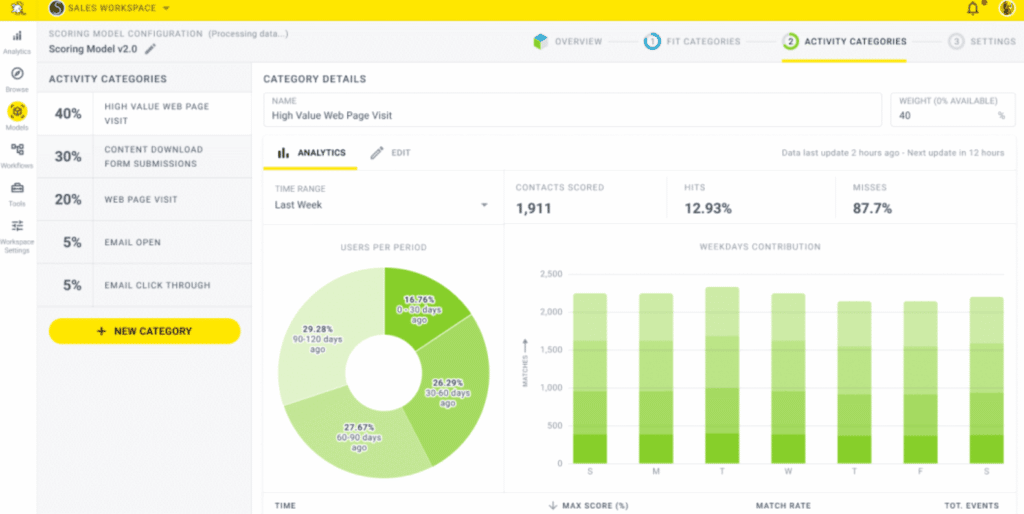
This could include purchases made in-store, pages viewed online, emails opened, demos booked, or tickets filed to customer support.
P.S We have an incredible guide on the top 5 lead scoring criteria you should use to when creating your first model if you need it.
The term lead scoring (and in fact, the entire methodology) was originally derived for one thing: to help sales weed out the good leads from the duds.
However, applying the same scoring logic to a different goal (churn reduction, finding upsell opportunities, etc) is not only possible with predictive lead scoring, it’s nearly tailor-made for it.
At Breadcrumbs, we like to call this contact scoring.
You can use Breadcrumbs to leverage scoring models for each stage of the customer journey, nust just trying to get a lead on a sales call. You can use firmographic data (such as Job title and Industry) and engagement data (such as Online and Offline activities) to see which users are prime for a sales opportunity and route back this information to your sales team so they can act fast.
This includes high-value leads that are ready to convert into paying customers, but it also includes existing customers who may be a great fit for upselling or cross-selling.
Existing customers who are currently hitting the top limit of their current SaaS plan, for example, are great candidates for a potential upsell. And those who love your copywriting AI service may also benefit from the help of an actual copywriter or a copy strategist—a separate product you offer that they haven’t taken advantage of yet.
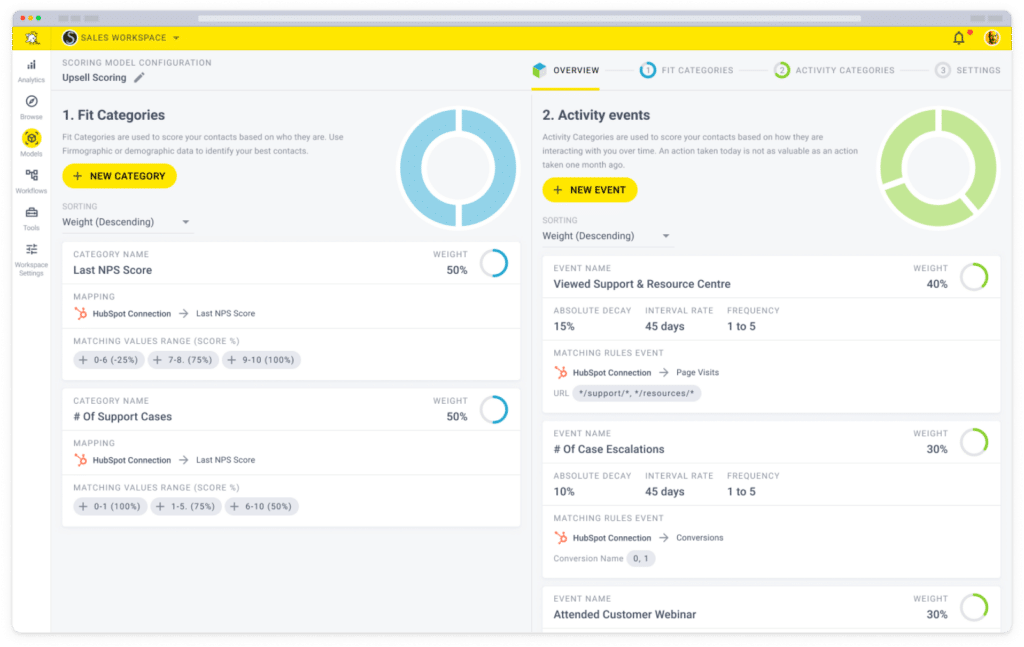
You want to maximize revenue anywhere you can, and that means looking at your existing client base, too.
By this time, you’re probably wondering how you can pitch yet another marketing tool to your executive team.
When thinking about predictive lead scoring benefits, there are a few considerations as you introduce predictive lead scoring into your lead management process.
This is the natural evolution of lead scoring, and while AI-based/predictive lead scoring has been around for a while, we’re at the tipping point where you will start to see more companies embrace machine-learning scoring.
HubSpot is the CRM of choice for many people out there, and for good reason. It has plenty of data available to you, and it only makes sense to take full advantage of that.
HubSpot’s app ecosystem can provide details about who the user is, how they’re engaging with you (website pages visited, etc.), and what they’re interested in, making it a great choice for those looking to get started with lead scoring.
However, the scoring models you’ll be getting are the traditional scoring type. That typically means they’re inflexible, hard to update, and can give you outdated information and incorrect intent signals.
At Breadcrumbs, we live and breathe all things related to scoring leads and contacts and have fully embraced the incredible power of predictive lead scoring technology. We have specialized dashboards and analytics that focus exclusively on this singular purpose, giving gives you more actionable data that your marketing and sales teams can use close better deals, faster.
The solution? Using Breadcrumbs and Hubspot together for perfect lead scoring harmony.
We don’t just have an integration with HubSpot—we’re a member of the Gold-level solutions partner program and certified by the HubSpot academy.
This means that we can help create your models and automation inside HubSpot, including:
If you want to learn more about how to use lead scoring to elevate your sales and marketing strategy, you can grab your forever-free account here.
There is no one type of data or source of data that is going to solve all your problems. Still, when you combine this data together alongside the objectives of what you are looking to get out of lead scoring, predictive lead scoring can undoubtedly assist you along your demand generation journey.
A contact-scoring software like Breadcrumbs leverages your data to crunch the numbers using machine learning to determine when your sales teams need to take action.
We’ll combine data from all of your touchpoints (your CRM, marketing automation tools, and existing product usage tools) to give you a thorough view of what activities are driving behavior—and we’ll let you stay in the driver’s seat, giving you full visibility and control while offering some helpful suggestions where needed.
Traditional lead scoring models rank prospects against a scale that represents the perceived value each lead brings to the organization, based on demographics and firmographics. The purpose of these models is to prioritize leads, helping sales and marketing teams concentrate on those most likely to convert into customers.
Predictive lead scoring is a more advanced approach to lead scoring, which involves using sophisticated algorithms, often powered by machine learning and internal contact activity, to predict how likely a lead is to convert into a customer.
Traditional lead scoring is based on a set of predetermined criteria and subjective assumptions, while predictive lead scoring uses machine learning algorithms to analyze vast amounts of data and identify the most relevant predictors of lead quality.
Yes, predictive lead scoring models can be tailored to fit a company’s unique sales process and business objectives. This customization allows companies to prioritize leads according to their specific criteria, which can lead to higher conversion rates and a more efficient sales pipeline. Sales and marketing teams can then use the data to evaluate the results of their efforts.
Predictive lead scoring enables companies to stay ahead of the competition, by providing insights into customer behavior and predicting which leads are most likely to convert. It can also help to identify potential roadblocks in the sales process and provide guidance on how to overcome them.
Predictive lead scoring can be integrated with customer relationship management (CRM) systems and marketing automation software to create a seamless workflow that enables companies to manage leads more effectively and efficiently. This integration can also help to streamline sales and marketing efforts, resulting in greater ROI and business growth. Companies can also create multiple lead scores to score contacts at every stage of the funnel, not just the top.
Ready for the next step? Book your demo so we can talk about how to define your objectives and show you how we can help you develop lead-scoring models to drive real revenue.